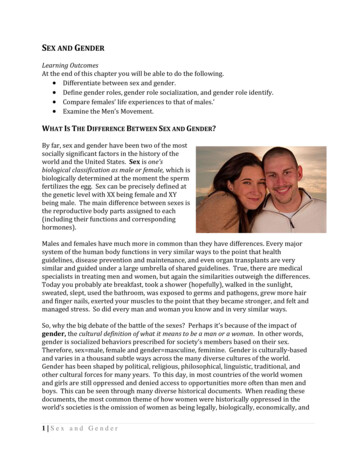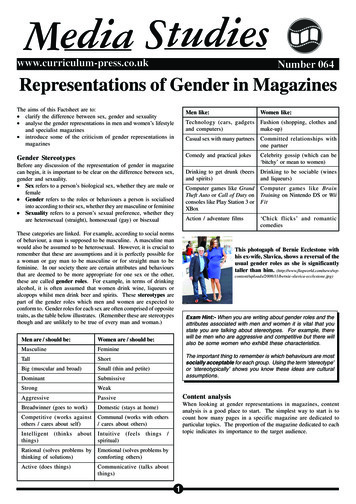
Transcription
Healthy Gender Developmentand Young ChildrenA Guide for Early ChildhoodPrograms and Professionals
This document was developed with funds from Grant #90HC0014 for the U.S.Department of Health and Human Services, Administration for Children andFamilies, Office of Head Start, Office of Child Care, and by the National Centeron Parent, Family, and Community Engagement. This resource may beduplicated for noncommercial uses without permission.Visit our PFCE web portal on theOffice of Head Start Early Childhood Learning and Knowledge Center, ilyContact us: PFCE@ecetta.info 866-763-6481
Healthy Gender Development and Young ChildrenA Guide for Early Childhood Programs and ProfessionalsO v er vi e wHealthy Gender Development and Young Children: A Guide for Early Childhood Programs andProfessionals offers practical guidance for teachers, caregivers, parents and staff. It draws ondecades of research on child and gender development, and experiences of early childhoodeducators, pediatricians, and mental health professionals.We hope you find this resource helpful in your work to promote children’s resilience and earlylearning. As one of the adults in young children’s lives, you can play an important role in guidingchildren as they explore one of their most pressing questions: Who am I?This guide is organized by the following topics: What We Know. Learn about the research regarding healthy gender development andimportant terms.What Programs Can Do. Explore strategies for creating a safe and nurturing learningenvironment for children.What You Can Do. Practice responding to children’s feelings about their own and eachother’s gender expression.Children’s Books That Support Healthy Gender Expression. Find a selection ofchildren’s books for children ages 2 and up.Related Resources and Selected References. Discover resources and referencesabout healthy gender development and young children.Healthy Gender Development and Young Children1
How Children Learn about Gender RolesGender in Young ChildrenAs young children develop, they begin to exploregender roles and what it means to be a boy or a girl.Cultures provide expectations for boys and girls, andchildren begin learning about gender roles from thenorms of their family and cultural background. Theyalso hear messages about gender roles from thelarger world around them.At birth, a child is legally assigned agender based on physical biology(female or male). Young childrenmay think of gender as one of manypersonal characteristics.Through their interactions and their play exploration,children begin to define themselves and others inmany ways, including gender. Children may ask theirparents and teachers questions about gender, takeon “boy” and “girl” roles in dramatic play and noticedifferences between the boys and girls they know.They may choose certain toys based on what theythink is right for boys or girls. They may also makestatements about toys and activities that they thinkare only for girls or only for boys (Langlois, & Downs,1980; O’Brien, Huston, & Risley, 1983; Egan, Perry, &Dannemiller, 2001).The ability to recognize when things are the same ordifferent is an important skill that children develop overtime. It’s only natural that they start asking questions tohelp them sort out the differences between boys andgirls. It’s easy to see how they may think that being aboy means doing some things and liking some things,and being a girl means doing and liking other things.2Gender ExpressionWhen a child (or adult) choosesactivities, behaviors or clothingthat our culture defines as typicallymale or female, it is called genderexpression. Choices can be alignedwith a person’s biologically assignedgender, like a boy playing with trucks.The choices may also be different,like when a girl plays with trucks.From a young child’s perspective,playing with a toy or wearingcertain clothing simply means“I like this.” Children do not yethave the understanding of howtheir choices’ may be commonlyassociated with one gender oranother.From a teacher/staff perspective,making these kinds of choices is partof healthy child development. This ishow children express their developingsense of self.(American Psychological Association,2015)Healthy Gender Development and Young Children
While many clear categories exist—a color is not a fruit and a dog is not a tree—many things thatmay have traditionally been limited to one gender or another are not inherently male or female.We can help children develop an understanding of categories that can include both boys andgirls by such simple, straightforward responses as “toys are toys” and “clothes are clothes.”These messages can help children learn that any child can, for example, play with any toy ordress up in any kind of clothing.Stages of Gender Development in Early ChildhoodA Note about Gender and PlayGender and Gender IdentityFor most children in the United States,gender and gender identity are notso different. Children usually choosetoys and activities associated with theirphysical gender.For more than 50 years, child developmentresearchers have studied how young childrenlearn and think about gender (Kohlberg, 1966;Bem, 1981; Martin & Halverson, 1981; Ruble &Martin, 1998; Bussey & Bandura, 1999; Ruble,Martin, & Berenbaum; Trautner, et al., 2003; Miller,et al., 2006; Zosuls et al., 2009).Other children choose activities thatare associated with another gender.It’s hard for them to understand whythey can’t play the games that interestthem, or play with the children theylike most. From a child’s perspective,that’s like being told that your favoritecolor has to be red, but you know yourfavorite color is blue.Children learn the social meanings of gender fromadults and culture. Beliefs about activities, interests,and behaviors associated with gender are called“gender norms,” and gender norms are not exactlythe same in every community.(American Academy of Pediatrics,2015)Young children look to caring adults to help themunderstand the expectations of their society and todevelop a secure sense of self. Children are morelikely to become resilient and successful when theyare valued and feel that they belong (AAP HealthyChildren, 2015; Kohlberg, 1966; Ramsey, 2004).Healthy Gender Development and Young Children3
Research has identified several stages of gender development:Infancy. Children observe messages about gender from adults’ appearances, activities, andbehaviors. Most parents’ interactions with their infants are shaped by the child’s gender, andthis in turn also shapes the child’s understanding of gender (Fagot & Leinbach, 1989; Witt, 1997;Zosuls, Miller, Ruble, Martin, & Fabes, 2011).18–24 months. Toddlers begin to define gender, using messages from many sources. As theydevelop a sense of self, toddlers look for patterns in their homes and early care settings. Genderis one way to understand group belonging, which is important for secure development (Kuhn,Nash & Brucken, 1978; Langlois & Downs, 1980; Fagot & Leinbach, 1989; Baldwin & Moses, 1996;Witt, 1997; Antill, Cunningham, & Cotton, 2003; Zoslus, et al., 2009).Ages 3–4. Gender identity takes on more meaning as children begin to focus on all kinds ofdifferences. Children begin to connect the concept “girl” or “boy” to specific attributes. Theyform stronger rules or expectations for how each gender behaves and looks (Kuhn, Nash, &Brucken 1978; Martin, Ruble, & Szkrybalo, 2004; Halim & Ruble, 2010).Ages 5–6. At these ages children’s thinkingmay be rigid in many ways. For example,5- and 6-year-olds are very aware of rulesand of the pressure to comply with them.They do so rigidly because they are not yetdevelopmentally ready to think more deeplyabout the beliefs and values that manyrules are based on. For example, as earlyeducators and parents know, the useof “white lies” is still hard for them tounderstand.Researchers call these agesthe most “rigid” period of gender identity(Weinraub et al., 1984; Egan, Perry, &Dannemiller, 2001; Miller, Lurye, Zosuls, &Ruble, 2009). A child who wants to do orwear things that are not typical of his genderis probably aware that other children find it strange. The persistence of these choices, despitethe negative reactions of others, show that these are strong feelings.Gender rigidity typically declines as children age (Trautner et al., 2005; Halim, Ruble,Tamis-LeMonda, & Shrout, 2013). With this change, children develop stronger moralimpulses about what is “fair” for themselves and other children (Killen & Stangor, 2001).4Healthy Gender Development and Young Children
Children need a safe and nurturing environment to explore gender and gender expression. It’simportant for all children to feel good about who they are and what they can do.Sometimes we unintentionally expect and encourage particular behaviors and traits based on achild’s gender. For example, adults tend to comment on a girl’s appearance, saying things like“Aren’t you adorable?” or “What a pretty dress!”On the other hand, comments about boystend to center on their performance with afocus on abilities, such as “You’re such a goodclimber!” or “You’re so smart.” As an adultsupporting healthy development, you candevelop a habit of commenting on who theyare as individuals.You can foster self-esteem in children ofany gender by giving all children positivefeedback about their unique skills and qualities. For example, you might say to a child,“I noticed how kind you were to your friendwhen she fell down” or “You were very helpfulwith clean-up today—you are such a greathelper” or “You were such a strong runner onthe playground today.”Healthy Gender Development and Young Children5
Create a Learning Environment that Encourages Healthy Gender DevelopmentChildren make sense of the world through imagination and play, by observing, imitating, askingquestions, and relating to other children and adults (Vygotsky & Cole, 1978). Here are a fewways you can support these ways of learning: 6Offer a wide range of toys, books, andgames that expose children to diversegender roles. For example, chooseactivities that show males as caregiversor nurturers or females in traditionallymasculine roles, such as firefighters orconstruction workers.Provide dramatic play props that givechildren the freedom to explore anddevelop their own sense of gender andgender roles. Recognize that this mayfeel uncomfortable for some providers,teachers, and parents. Be ready to haveconversations to address the value ofthis kind of play.Avoid assumptions that girls or boysare not interested in an activity that may be typically associated with one gender orthe other. For example, invite girls to use dump trucks in the sand table and boys totake care of baby dolls.Use inclusive phrases to address your class as a whole, like “Good morning,everyone” instead of “Good morning, boys and girls.” Avoid dividing the classinto “boys vs. girls” or “boys on one side, girls on the other” or any other actionsthat force a child to self-identify as one gender or another. This gives children asense that they are valued as humans, regardless of their gender. It also helps allchildren feel included, regardless of whether they identify with a particular gender.Develop classroom messages that emphasize gender-neutral language, like “Allchildren can . . .” rather than “Boys don’t . . .” or “Girls don’t . . .”Help children expand their possibilities—academically, artistically, and emotionally.Use books that celebrate diversity and a variety of choices so that children can seethat there are many ways to be a child or an adult. Display images around the roomthat show people in a wide variety of roles to inspire children to be who they wantto be.Healthy Gender Development and Young Children
Demonstrate Support for Children’s Gender ExpressionAlmost all children show interest in a wide range of activities, including those that somewould associate with one gender or the other. Children’s choices of toys, games, and activitiesmay involve exploration of male and female genders. They may express their own emerginggender identity through their appearance, choice of name or nickname, social relationships,and imitation of adults. Show support for each child’s gender expressions by encouraging allchildren to make their own choices about how to express themselves.Regardless of whether they are boys orgirls, children may act in ways that otherscategorize as feminine or masculine: theymay be assertive, aggressive, dependent,sensitive, demonstrative, or gentle (Giles &Heyman, 2005).Research has shown that when girls and boysact assertively, girls tend to be criticized as“bossy,” while boys are more likely to bepraised for being leaders (Martin & Halverson,1981; Theimer, Killen, & Stangorm, 2001; Martin& Ruble, 2004, 2009). To avoid this kind ofunintentional gender stereotyping, try todescribe rather than label behavior. “I seeyou have a strong idea, and you need yourfriends to help with it. Could you let themchoose what they want to do?”Engage in Discussions about Healthy Gender DevelopmentDifferent perceptions among adults, whether staff or parents, of gender development can beused as a basis for discussion. Some staff and parents may feel uncomfortable with a child’splay when it explores a gender role the adult does not associate with that child’s biological sex.It can be helpful to remember that play is the way that children explore and make meaning oftheir world. Be prepared to have conversations that honor a range of feelings, make space forquestions, address concerns, discuss varied points of view, and offer resources.You can also offer a developmental perspective on why it’s important to let children exploredifferent gender roles—once you have a sense that parents seem open to this. For example,you could start by saying, “I understand that seeing Isaac playing house and wearing an apronin the kitchen makes you feel uncomfortable. Can you tell me a little more about that?”After you’ve listened, you may decide that it would be helpful to offer some developmentalinformation by saying, for example, “We see this kind of play as a way for Isaac to explore theworld around him, try on different ideas, and mirror what he sees family members, communitymembers, or media characters doing.”Healthy Gender Development and Young Children7
Understand Developmentally Appropriate Curiosity about BodiesCuriosity about people’s bodies is natural for children as they begin to notice differencesand think of themselves as a boy or girl. Yet some exploration is not appropriate in an earlychildhood development program. If questions come up in the bathroom or if children want tolearn about their friends’ bodies, let them know that most children have questions about theirbodies and the differences between girls’ and boys’ bodies. That way they won’t feel ashamedwhen you remind them that their bodies are private.If children demonstrate this kind of natural curiosity in your setting, you can share yourobservations with the children’s parents and ask them if they want to talk more about it. Parentsmay react differently, depending on their comfort level with you and this topic, and on whatthey’ve discussed with their children at home.When your relationship with a parent is strong and trusting, you might say, “I know this can beuncomfortable to talk about, but I wanted to share an observation I made today. I noticed yourchild and a friend were talking about their different body parts on the way to the bathroom. I’mwondering if you’ve seen the same kind of curiosity at home and if you’ve talked about it?” Ifthey haven’t, ask if they’d like some ideas about how to answer their children’s questions whenthey do come up. Offer resources if they are interested in learning more.Understanding Differences Between Gender and Sexual OrientationGender expression, gender identity and sexual orientation are not the same. Gender identity isabout who you feel you are as a person. Sexual orientation is about the gender of the peopleyou are sexually attracted to. A young child’s expression of gender-related preferences (infriends, activities, clothing choices, hairstyle, etc.) does not necessarily predict what their genderidentity or sexual orientation will be later in life (American Psychological Association, 2015).The age at which gender identity becomes established varies. Gender identity for some childrenmay be fairly firm when they are as young as two or three years old (AAP, 2015; Balwin & Moses,1996; Gender Spectrum, 2012; Zosuls et al., 2009). For others it may be fluid until adolescenceand occasionally later.The age at which an individual becomes aware of their sexual orientation, that is, theirfeelings of attraction for one gender or the other or both, also varies. Such feelings mayemerge during childhood, adolescence, or later in life (Campo-Arias, 2010; GenderSpectrum, 2012). At present, child development experts say there is no way to predictwhat a child’s sexual orientation or gender identity will be as an adult (Bryan, 2012).If parents or staff members have questions or are concerned about a child’s genderexpression, assure them that you and your program are available for ongoing discussions.Family acceptance of a child’s gender identity is a critical factor in the child’s development(AAP, 2015; Gender Spectrum, 2012; Ryan et al, 2010). Whatever a child’s emerginggender identity, one very important message that caring adults can give to young childrenis that they are healthy, good human beings. Be prepared to share resources that can helpfamily members learn more about gender in young children.8Healthy Gender Development and Young Children
Interactions with Children, Staff, and ParentsSince young children learn by observing our words and actions, consider these strategies whendealing with children’s feelings about their own and each other’s gender expression: Share ideas with other providers about how to stop hurtful, gender-related teasing andre-direct children to positive activities.Practice what you want to say and do. See the examples in the next section forinteracting with children and adults.Know your educational goals and how they are connected to social-emotionalwell-being in children. Help children choose kindness.Use instances of teasing as opportunities to help all the children understand other’sfeelings and their own. Help them understand how their words might make their friends feel. Help them to learn to say “I’m sorry” and to show that they really mean it. Talk one-on-one with children who have teased another child. They are oftenconfused about the hurt they cause and may be frightened by their own actions.They need to understand that hurting other children is not allowed. But they alsoneed to know that you have confidence that they can learn to control themselves.Be sure to let them know that you are ready to forgive them once they have madea sincere apology.Help children to become resilient. Help those who are hurt by teasing to find simpleresponses to put a stop to it and affirm their positive feelings about themselves.When you hear children making comments similar to the ones below (in italics), you mightconsider these responses:“You can’t play in the kitchen area. You’re a boy!” “We can all learn together how to make a recipe and clean up the kitchen.” “I’m going to play in the kitchen with any of the children who like to play there.”Healthy Gender Development and Young Children9
“Why does Diego always want to dress like a girl?” “There are lots of different ways that boys can dress and lots of different ways that girlscan dress.”“Clothes are clothes. He likes to wear theclothes that he feels comfortable in.”“Why does she always play with the boys?” “Those are the games that she likes toplay, just as there are different gamesthat you like to play.”“She can play with whoever she wantsto, just like you.”“You’re a girl!” (said in an insulting tone to achild who identifies as a boy). “It’s not okay to call someone a ‘girl’ tomake them feel bad.”“Boys are better at sports than girls.” “Some boys and girls are good at sports,and some are not. All children havedifferent things that they are good at.”When a caregiver shares questions similar to the ones below (in italics), you might considerthese responses:“Mercedes uses a boy’s name when they play pretend. Her grandmother said not to let her dothat. I can’t go against the grandmother.” “Let’s talk this over with her grandmother and learn more about her views on this, whythis is important to her, and what she would suggest. We can share our observation thatMercedes seems to know she disapproves, yet still really seems intent on using a boy’sname right now in her pretend play. Maybe then we could share with her our view ofthis kind of play as a way to use creativity to learn about one’s self and other people.She may still disagree, but getting this dialogue going would be a good start.”“Zach’s dad makes fun of him when he sees him playing with girls. Zach now gets nervouswhenever his father comes to pick him up. What can I say to the dad?” “Zach enjoys playing with the other children in our program. We encourage the boysand girls to play together to learn from each other.”“One of the other teachers punishes Taylor when she acts like a boy. What should I do?” 10“I noticed that you scolded Taylor when she acted like a boy. Can we talk more aboutwhy you did that? You might remember that our educational approach encourages allchildren to play pretend. We believe creativity is a part of learning and development.”Healthy Gender Development and Young Children
“Sometimes parents ask about other children. For example, a parent might say, ‘I heard thatDiego calls himself Isabella now, and he wears dresses every day. Why would his parents lethim do that?’” How can I answer this question and discourage gossip? “Well, normally I would not discuss details about another child, but in this case I havetalked with Diego’s dad about this and how he would like us to address these types ofquestions as they come up. Isabella identifies as a girl and uses female pronouns, suchas “she” and “her.” As early educators, we know some children are very clear at youngages that their gender expression is not the one they were assigned at birth based ontheir biology. Isabella’s parents love her, and they are trying to do what is best for her—just as you are doing for your child.”When a provider wants to talk with a child’s parents or guardians about gender-relatedteasing, similar to the example below (in italics), you might consider this response:“A child called a boy a ‘“girl”’ at school today. It seemed intended as an insult. What can I say?” “Your child usually gets along so well with the other children. So when your child calleda boy a ‘girl,’ as if that were a bad thing, we wanted to be sure to talk this over with you.Your son is such a leader, and we know he can be a positive one. We want to make surethat the children know that the words ‘girl’ and ‘boy’ aren’t insults, and that this is a safeand secure environment for all of them.Do you have some ideas about how wecan work with your son as we work withall the children on this?”Simple Messages You Can Share with AllChildrenAn essential part of children’s school readinessis developing self-confidence and resilience.Research shows that, even in early learningsettings, boys and girls perform less well whenthey have negative concepts about theirgender. Comments like “Girls can’t throw!” or“Boys always get into trouble!” can make themdoubt their natural abilities (Hartley & Sutton,2013; Del Rio & Strasser, 2013; Wolter, Braun, &Hannover, 2015).Early learning environments are important places to teach children language and behavior thathelps them all feel good about who they are and how to recover from the hurts they may causeeach other.Healthy Gender Development and Young Children11
Look for opportunities to help children practice positive language they can use with each other.Here are some examples that you can use to create your own: “Girls and boys can be friends with eachother.”“Everybody can play in the kitchen/toolarea/swing set.” “Running games are for everyone.” “Hair is hair. That is how she/he likes it.” 12“Boys and girls can be good at sports/writing/sitting still.”“Boys and girls can wear what they likeat our school.”“Colors are colors. There aren’t boycolors or girl colors. All children likedifferent colors.”Healthy Gender Development and Young Children
Books for Ages 2 and UpA Fire Engine for Ruthie. Newman, L. (Ages 2–5).Nana has dolls and dress-up clothes for Ruthie to play with, but Ruthie would rather have a fireengine.Of Course They Do! Boys and Girls Can Do Anything. Roger, M.-S, Sol, A., & Jelidi, N. (Ages 2–5).Attempting to break gender roles, this book depicts boys and girls engaging in activities that aresupposedly associated with the opposite sex. Boys cook, jump rope, take care of babies, anddance, while girls play sports and drive cars.Books for Ages 3 and UpThe Story of Ferdinand. Leaf, M., & Lawson, R. (Ages 3–5).Ferdinand is the world’s most peaceful—and—beloved little bull. While all of the other bullssnort, leap, and butt their heads, Ferdinand is content to just sit and smell the flowers under hisfavorite cork tree.Who Has What? All About Girls’ Bodies and Boys’ Bodies. Harris, R. H., & Westcott, N. B. (Ages3–7).Humorous illustrations, conversations between two siblings, and a clear text all reassure youngkids that whether they have a girl’s body or a boy’s, their bodies are perfectly normal, healthy,and wonderful. This is helpful for parents or families when their children start to ask questionsabout their bodies.For Ages 4 and UpAmazing Grace. Hoffman, M. (Ages 4 and up).Grace loves stories, whether they’re from books, movies, or the kind her grandmother tells. Sowhen she gets a chance to play a part in Peter Pan, she knows exactly who she wants to be.Healthy Gender Development and Young Children13
Ballerino Nate. Bradley, K. B., & Alley, R. W. (Ages 4 and up).Nate decides he wants to dance after attending a recital, but his older brother tells him thatboys can’t be ballerinas. Nate does wonder why he is the only boy in the class; but with hismom’s support, Nate follows his dream.Jacob’s New Dress. Hoffman, S., Hoffman, I., & Case, C. (Ages 4–8).Jacob loves playing dress-up, when he can be anything he wants to be. Some kids at school sayhe can’t wear “girl” clothes, but Jacob wants to wear a dress. Can he convince his parents to lethim wear what he wants?Kate and the Beanstalk. Osborne, M. P., & Potter, G. (Ages 4–8).Kate (instead of Jack) trades her family’s cow for magic beans and climbs the beanstalk to find akingdom in the clouds.My Princess Boy. Kilodavis, C., & DeSimone, S. (Ages 4–8).Dyson loves pink, sparkly things. Sometimes he wears dresses. Sometimes he wears jeans.He likes to wear his princess tiara, even when climbing trees. He’s a Princess Boy.The Paper Bag Princess. Munsch, R. (Ages 4 and up).Princess Elizabeth is slated to marry Prince Ronald when a dragon attacks the castle andkidnaps Ronald. In resourceful and humorous fashion, Elizabeth finds the dragon, outsmartshim, and rescues Ronald—who is less than pleased at her un-princess-like appearance.The Princess Knight. Funke, C. (Ages 4–7).Despite the taunting of her brothers, Princess Violetta becomes a talented knight, and when herfather proposes to give her hand in marriage to the knight who wins a tournament, Violetta usesher brains as well as her brawn to outwit him.Red: A Crayon’s Story. Hall, M. (Ages 4–8).Red has a bright red label, but he is, in fact, blue. His teacher tries to help him be red (let’s drawstrawberries!), his mother tries to help him be red by sending him out on a play date with ayellow classmate (go draw a nice orange!), and the scissors try to help him be red by snippinghis label so that he has room to breathe. But Red just can’t be red, no matter how hard he tries!Finally, a new friend offers a brand-new perspective, and Red discovers what readers haveknown all along. He’s blue!14Healthy Gender Development and Young Children
Relat ed Re s o u r c e sAmerican Academy of Pediatrics’ Healthy Children.org:Gender Identity in r-Confusion-In-Children.aspxSouthern Poverty Law Center—Teaching Tolerance: NotTrue! Gender Doesn’t Limit ght (8) Positive Ways to Address Children’s GenderIdentity ldren/?slideId 46660We Are Different, We Are the Same: Teaching YoungChildren about e-teaching-youngchildren-about-diversityGender Spectrum: Resources for Gender ources/education-2/#cuatroWelcoming Schools: Developing a Gender ool/S el ect e d Re f e r e n c e sAmerican Academy of Pediatrics. (2015, November 11).Gender identity development in children. Retrieved -Confusion-In-Children.aspxAmerican Psychological Association. (n.d.) DefinitionsRelated to Sexual Orientation and Gender Diversity inAPA Guidelines and Policy Documents.Antill, J. K., Cunningham, J. D., Cotton, S. (2003). Gender-role attitudes in middle school: In what ways doparents influence their children? Australian Journal ofPsychology
girls by such simple, straightforward responses as “toys are toys” and “clothes are clothes.” These messages can help children learn that any child can, for example, play with any toy or dress up in any kind of clothing. Stages o











